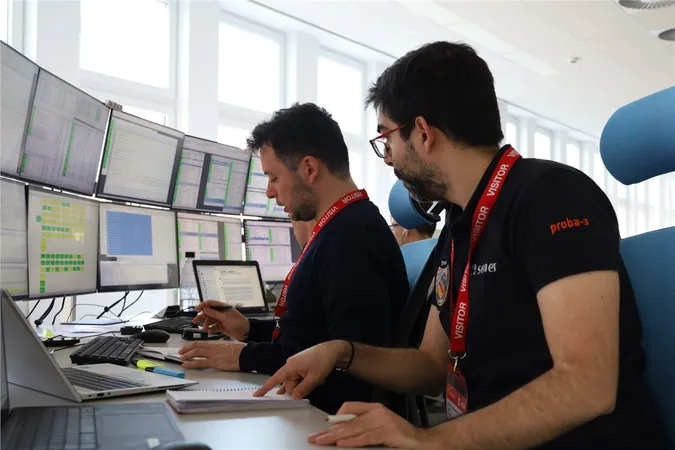
Historic Milestone Achieved: Proba-3's First Autonomous Formation Flight
2025-03-28
Author: Sarah
Historic Milestone Achieved: Proba-3's First Autonomous Formation Flight
In a groundbreaking achievement for space exploration, the Proba-3 mission has successfully conducted its first autonomous formation flight, marking a historic moment in the realm of precision spacecraft maneuvering. This revolutionary mission involves two satellites, the Coronagraph and the Occulter, which will fly in perfect formation, simulating a single large spacecraft, separated by just 150 meters in space.
The operation hinges on meticulously timed commands directed to both satellites as they orbit Earth. This remarkable formation allows the Occulter to cast a 5-centimeter shadow onto the Coronagraph, precisely aligning it with the Sun to facilitate the study of the faint solar corona. This intricate alignment occurs once per orbit, setting the stage for groundbreaking solar research.
Unlike previous missions that utilized formation flying technology, Proba-3’s ingenuity lies in its ability to maintain relative positions within mere millimeters without ground control intervention for several hours. Earlier this week, the mission team at ESA’s ground control center in Redu undertook the first critical phase in achieving this formation. The satellites were brought from an initial distance of 600 meters down to a targeted 144 meters, positioning them for optimal alignment for the studies ahead.
Mission manager Damien Galano explained the intricate procedures involved in this initial alignment, emphasizing the use of GPS information to ascertain the exact locations of the satellites. They fired thrusters to guide the spacecraft into close proximity, after which it was up to the satellites to take over, autonomously maintaining their positioning for several hours.
With cutting-edge technology on board, Proba-3 utilizes a Visual Based System that employs a wide-angle camera on the Occulter tracking LED lights on the Coronagraph, alongside a narrow-angle camera for enhanced precision. This advanced system allows the satellites to communicate vital positional data with each other, facilitating real-time alignment adjustments without any ground control input.
Teodor Bozhanov, a systems engineer for Proba-3, elaborated on the operational dynamics, stating that the Occulter can send corrective instructions to the Coronagraph as needed. The sophisticated onboard sensors are designed to detect the alignment of the satellites, ensuring that the Coronagraph remains within the shadow cast by the Occulter throughout their orbit.
Over the past few days, the engineering team collected a substantial amount of data from this remarkable flight. This data will be instrumental in fine-tuning Proba-3’s systems, bringing them closer to achieving the ultimate goal of this mission: precise and autonomous formation flying. As Esther Bastida Pertegaz, another systems engineer on the project, remarked, the results of this mission will pave the way for more ambitious undertakings in the future.
What sets Proba-3 apart is the combination of innovative technologies that together create a unique operational framework for satellite formation flying. Many of these technologies were in their infancy just a decade ago, and the successful demonstration of their potential represents a significant leap forward for future space missions.
As the Proba-3 team combines expertise from various fields, including systems engineering, flight dynamics, and spacecraft operations, their collaborative efforts underscore the unity of vision directing ESA’s initiative. This successful demonstration not only reinforces Proba-3’s status as the world's first-ever precision formation flying mission but also heralds a new chapter in space exploration, where such sophisticated technology can be employed for a plethora of future scientific missions.
With projects like the deep space CubeSat HENON and the LUMIO CubeSat on the horizon, ESA’s General Support Technology Programme continues to promote pioneering research and innovation that will shape the future of space exploration. This is just the beginning of what promises to be a decade filled with exciting advancements. Keep your eyes on the stars!

 Brasil (PT)
Brasil (PT)
 Canada (EN)
Canada (EN)
 Chile (ES)
Chile (ES)
 Česko (CS)
Česko (CS)
 대한민국 (KO)
대한민국 (KO)
 España (ES)
España (ES)
 France (FR)
France (FR)
 Hong Kong (EN)
Hong Kong (EN)
 Italia (IT)
Italia (IT)
 日本 (JA)
日本 (JA)
 Magyarország (HU)
Magyarország (HU)
 Norge (NO)
Norge (NO)
 Polska (PL)
Polska (PL)
 Schweiz (DE)
Schweiz (DE)
 Singapore (EN)
Singapore (EN)
 Sverige (SV)
Sverige (SV)
 Suomi (FI)
Suomi (FI)
 Türkiye (TR)
Türkiye (TR)
 الإمارات العربية المتحدة (AR)
الإمارات العربية المتحدة (AR)